Sneaker Market Overview, 2031
The global sneaker market was valued at $131.1 billion in 2021, and is projected to reach $215.6 billion by 2031, growing at a CAGR of 5.3% from 2022 to 2031. The volume of global consumption shows a tendency of people of all ages using sneakers as casual and fashionable footwear. The market provides a range of footwear with variations in color, design, and price to meet the needs and financial capabilities of individual clients. The sneaker market size increased as a result of the adoption of attractive marketing and promotional techniques, the expansion of sales through online channels, and the introduction of novel products. Players in the market are investing more in brand development and marketing channels due to the intense competition in the industry. This draws attention to their presence and contributes to building their brand's worth so they can draw in more customers. Numerous small-scale producers compete fiercely with the world's largest shoe companies.
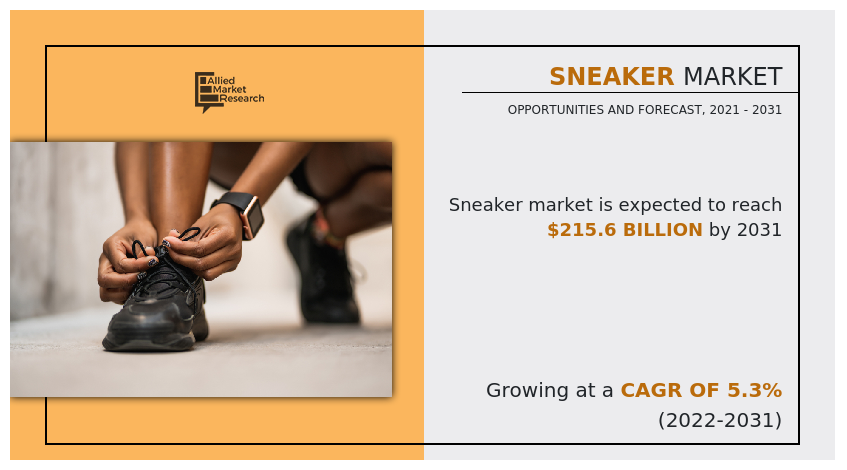
The sneaker market is segmented into Product Type, End User, Price Point, Category and Distribution Channel.
Global demand for e-commerce, which exclusively entails the purchasing and selling of goods and services through online platforms, is quite high. Online shopping is the most well-known type of e-commerce. By making it simpler and more convenient, it has streamlined the purchasing process for consumers. When compared to developing nations like India and China, developed nations like the United States and Japan are more popular for online shopping. Ten years ago, the retail environment was different than it is today. Due to the development of e-commerce, which makes buying simpler, easier, and more convenient, there is a tremendous market opportunity for sneakers.
Due to their widespread use in numerous environments, sneaker products are in high demand. Numerous consumer groups, including athletes and rock climbers, utilize footwear. Customers who are interested in fitness, gym visitors, and those who utilize them for light exercise routines are also present. In order to create the various styles of sneakers that are sold on the market, high-quality raw materials like leather, foam, and plastic are combined with innovative chemical additives. One of the key constraints on the sneaker market is the rise in environmental concerns. The government's and environmental organizations' proactive actions against pollution serve to limit the market. One of the primary contributors to the pollution of the rivers and environment is industry.
The global sneaker market is analyzed on the basis of product type, end user, price point, category, distribution channel, and region. By product type, the market is divided into low-top sneakers, mid-top sneakers, and high-top sneakers. By end user, it is divided into men, women, and kids. By price point, it is divided into luxury and economic. By category, it is classified into private label and branded. By distribution channel, it is divided into supermarkets/hypermarkets, specialty stores, brand outlets, e-commerce, and others. Region wise, the market is analyzed across North America, Europe, Asia-Pacific, and LAMEA.
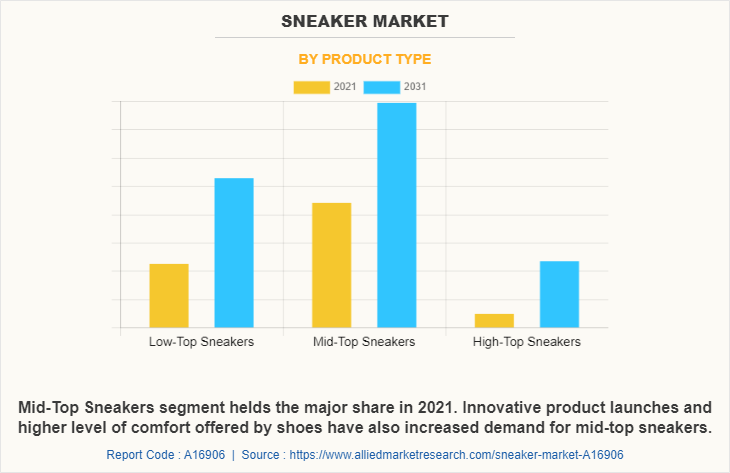
The mid-top sneakers segment dominates the global sneaker market. Increase in consciousness toward health and fitness has led to rise in demand for mid-top sneakers, primarily in developed countries. Innovative product launches and higher level of comfort offered by shoes have also increased demand for mid-top sneakers.
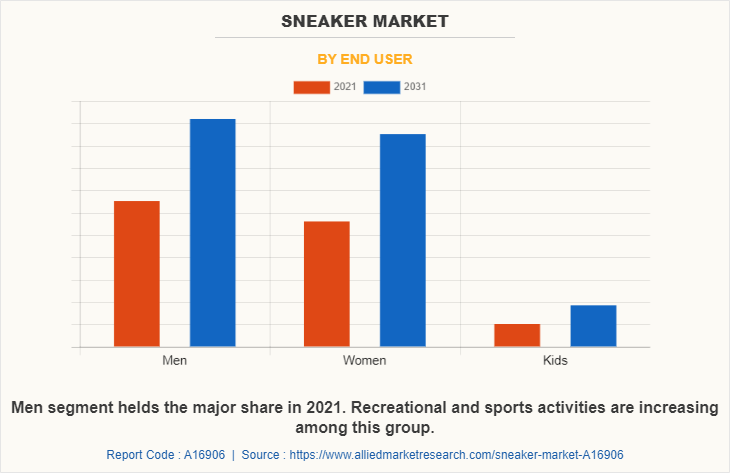
The men segment dominates the global sneaker market. The growth of the men's sneaker segment is being fueled by people being able to spend more on luxury items due to an increase in disposable income.
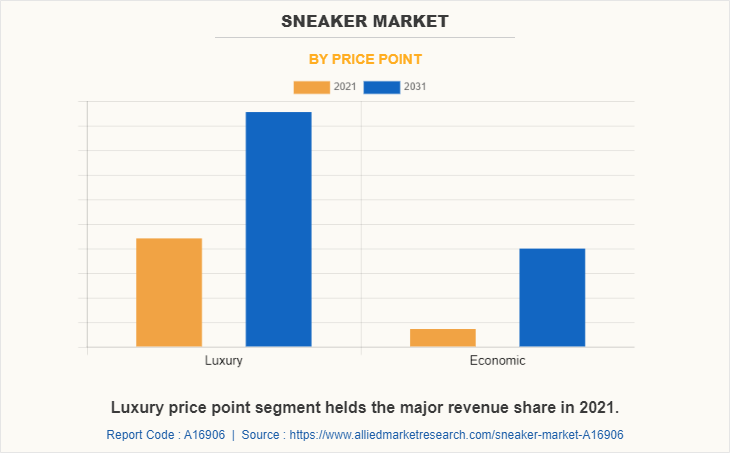
The luxury segment dominates the global sneaker market. A major factor projected to fuel the expansion of the global sneaker market is consumers' increased willingness to spend more on sneakers due to improved lifestyles and rising disposable income.
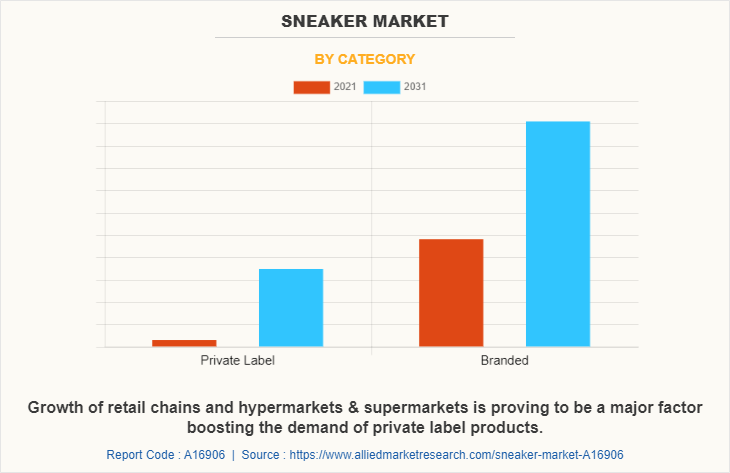
The branded segment exhibits the fastest growth in the global sneaker market. Consumers buying shoes through online sales channels prefer the branded ones, as they can afford them in low price. This factor is boosting the branded sneaker market.
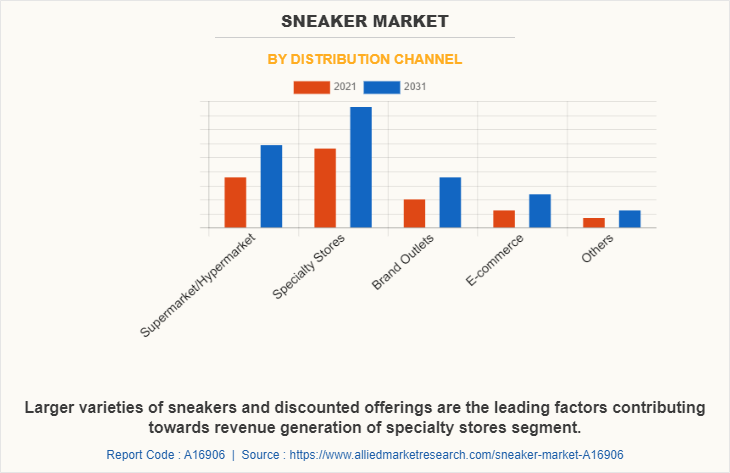
The specialty stores segment exhibits the fastest growth in the global sneaker market. Specialty stores offer options such as discounts as well as benefits of immediate gratification, which results in growth of the sneaker market.
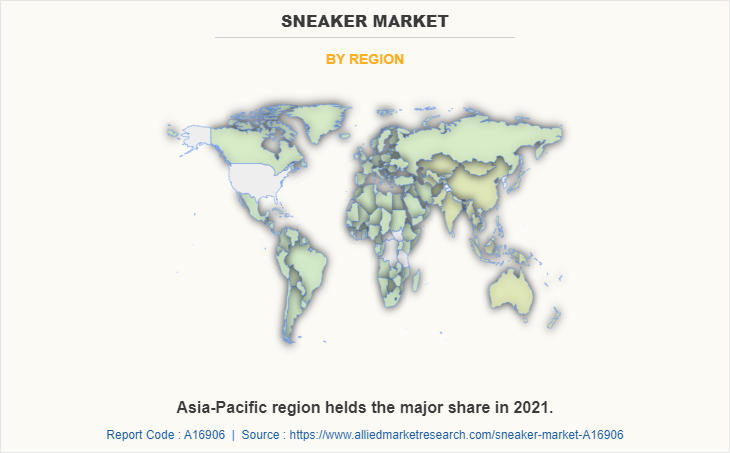
Region wise, Asia-Pacific dominated the market with the largest share during the forecast period. The Asia-Pacific market possesses growth potential for companies offering new and innovative footwear products. Increase in urbanization and surge in middle-class consumers in developing and developed markets have encouraged the adoption of convenience-oriented lifestyles, making sneaker more desirable for consumer of all age groups.
The number of people visiting fitness centers and engaging in indoor and outdoor exercise activities has increased as a result of the current global growth in health awareness. As a result, sneaker demand has increased across all age groups. Additionally, those who work choose fitness programs like swimming and running to be healthy and active. All age groups now have a need for sneakers as a result of this, which has increased the size of the sneaker market.
Along with rising internet penetration, more people are using various social media platforms. The majority of the industry's major companies develop strategies to market their goods and services on these social media channels. One of the main methods used by many businesses and sectors, including the market for wearable gadgets, to spread knowledge about their product offers among target customers on social media channels is social media marketing. Thus, the global sneaker market sees a crucial potential through its social media marketing approach to acquire momentum and eventually grow registration among its target categories, which also leads in increasing the demand for sneakers.
Although popular sneaker brands like Nike, Adidas, and Puma command high costs, the emergence of counterfeit brands is a result. In emerging economies where consumers are very price conscious, counterfeit brands are typically very common. The sale of the already-existing authentic shoe brands in these nations is hampered by this aspect. Global trend in the proportion of working women has increased demand for fashionable footwear that may be worn both formally and informally. Additionally, a rise in disposable income is enabling people to spend more on luxury items, which is fueling the expansion of the sneaker market.
The kid’s footwear market has been increasingly fueled by the sheer varieties of colors and designs which are available for kids wear over the past few decades. Customers are fascinated by the different materials and designs of footwear that drives the market. Kids who take part in fancy dress and similar competition held in day care facilities and schools are fascinated by products with new designs and colors. Increasingly awareness towards the health concerns of individuals across the world lead to use of the product fit for kids for all indoor as well as outdoor activities. Change in lifestyle, increasing involvement of kids in fitness regimes such as running, playing remaining healthy activities increases the demand of kids’ footwear.
As the cost of synthetic leather, chemicals and other raw material increases while the price of final product remains same restrains the sneaker market. Customers are delaying their footwear purchase from once in six months earlier to once in nine months now due to price hikes bought on by the increase in raw material costs at a time when the pandemic and unemployment have kept customer’s spending power from increasing to declining. Raw materials prices gone up almost 50 % and manufacturer were in very bad conditions as they are able to increase the prices at certain extent but not pass on the entire amount to the customers because customer income has not increased.
Rise in fashion trends is creating a demand for new products, which acts as an opportunity for the market. Consumers eagerly wait for new products or fresh arrivals in the market. Constantly changing fashion trends is expected to increase demand for new and fashionable products in the coming years. In line with the athleisure trend, consumers are increasingly seeking designer athletic shoes that include elements of sports design. One of the main reasons, sneakers are becoming popular among consumers was their introduction into sports, especially basketball because there was for never a particular shoe associated with basketball until Chuck Taylor came along. Thus, rise in fashion trends make opportunities for sneaker market in upcoming years.
The major players analyzed for the sneaker industry are 361 Degrees International Limited, Adidas Group, ANTA Sports Products Limited, Asics Corporation, Crocs Retail, Llc, Ecco Sko A/S, New Balance Inc., Nike, Inc, Peak Sports, Puma SE, Skechers U.S.A., Inc., Under Armour, Inc., VF Corporation, Wolverine World Wide, Inc, Xtep International Holdings Limited. Key players operating in the sneaker market have adopted product launch, business expansion, and mergers& acquisitions as key strategies to expand their sneaker market share, increase profitability, and remain competitive in the market.
Key Benefits For Stakeholders
- This report provides a quantitative analysis of the market segments, current trends, estimations, and dynamics of the sneaker market analysis from 2021 to 2031 to identify the prevailing sneaker market opportunities.
- The market research is offered along with information related to key drivers, restraints, and opportunities.
- Porter's five forces analysis highlights the potency of buyers and suppliers to enable stakeholders make profit-oriented business decisions and strengthen their supplier-buyer network.
- In-depth analysis of the sneaker market segmentation assists to determine the prevailing Sneaker Market Growth.
- Major countries in each region are mapped according to their revenue contribution to the global market.
- Market player positioning facilitates benchmarking and provides a clear understanding of the present position of the market players.
- The report includes the analysis of the regional as well as global sneaker Sneaker Market Demand, Sneaker Market Trendstrends, key players, market segments, application areas, and Sneaker Market Forecast.
Sneaker Market Report Highlights
| Aspects | Details |
| By Product Type |
|
| By End User |
|
| By Price Point |
|
| By Category |
|
| By Distribution Channel |
|
| By Region |
|
| Key Market Players | Under Armour Inc., Benetton Group S.r.l., Converse, Puma, Reebok, Adidas AG, New Balance, Nike, Inc., Hanesbrands Inc., Champion |
Analyst Review
According to the insights of CXOs of leading companies, due to its vast population and customers' high level of participation in sports in nations like China and India, the Asia-Pacific region accounts for the greatest share of the global sneaker industry. A rise in the demand for sneakers in the Asia-Pacific area is a result of government initiatives in these developing nations that have helped to popularize various sports. Since consumers in developing areas are more price sensitive than those in developed markets, there is a reduced demand for high-quality sneakers. Manufacturers are seeking for strategies to shift their manufacturing units toward industrial regions as a result of stringent government restrictions to reduce pollution and growing awareness of health and environmental sustainability. In order to increase their position in the sneaker market even further, players have turned to new launches and acquisitions as their growth strategy.
CXOs further added that the market for sneakers is expanding quickly due to rapid urbanization, changing demographics, rising middle class demand, and an increase in disposable income. Additionally, it is anticipated that the demand for items in the sports footwear and branded footwear categories would rise as demand for athletic footwear and branded footwear increases across all age groups. Sports-inspired fashions are becoming more popular among consumers. Additionally, the rise in the number of working women and their increased fashion awareness fuel the expansion of the sneaker market.
The global sneaker market size was valued at $131.1 billion in 2021, and is projected to reach $215.6 billion by 2031, registering a CAGR of 5.26% from 2022 to 2031.
The forecast period in the sneaker market report is 2022 to 2031.
The base year calculated in the sneaker market report is 2021.
The top companies analyzed for global sneaker market report are 361 Degrees International Limited, Adidas Group, ANTA Sports Products Limited, Asics Corporation, Crocs Retail, Llc, Ecco Sko A/S, New Balance Inc., Nike, Inc, Peak Sports, Puma SE, Skechers U.S.A., Inc., Under Armour, Inc., VF Corporation, Wolverine World Wide, Inc, Xtep International Holdings Limited.
The mid-top sneakers segment is the most influential segment in the sneaker market report.
Asia-Pacific holds the maximum market share of the sneaker market.
The company profile has been selected on the basis of key developments such as partnership, product launch, merger and acquisition.
The market value of the sneaker market in 2021 was $131.1 billion.
Loading Table Of Content...



